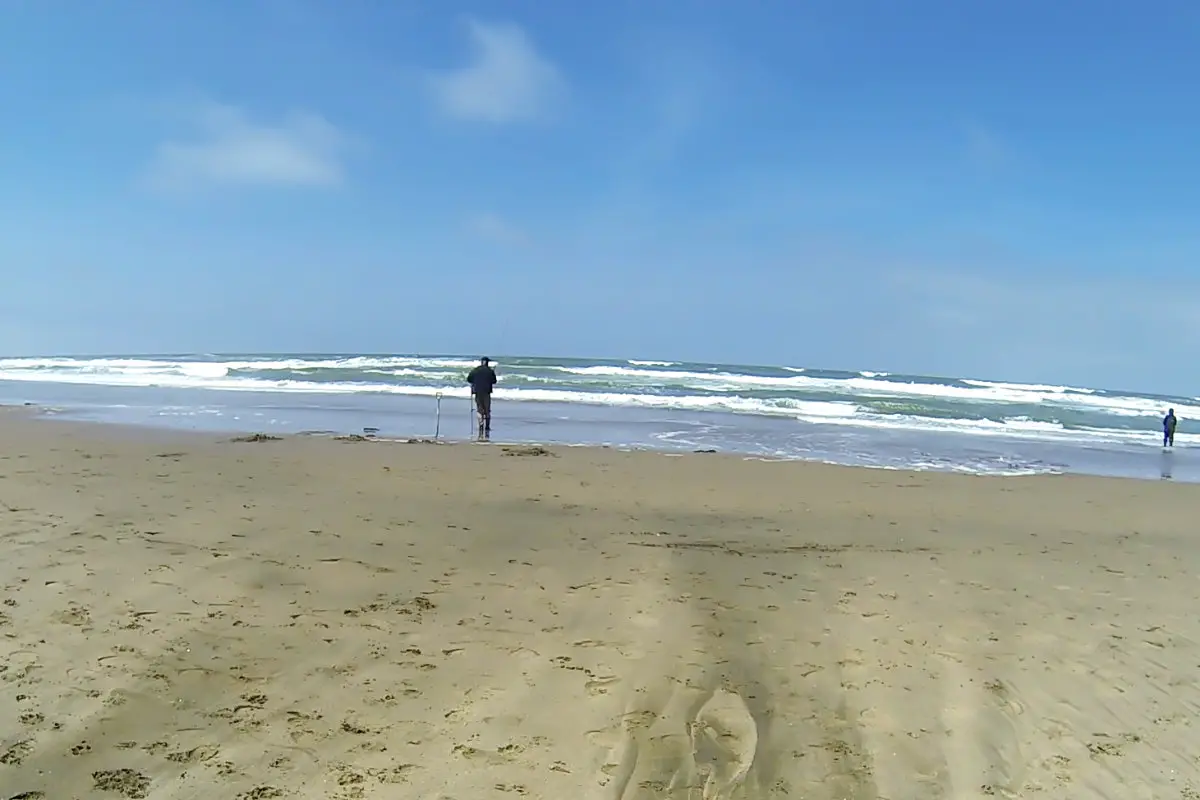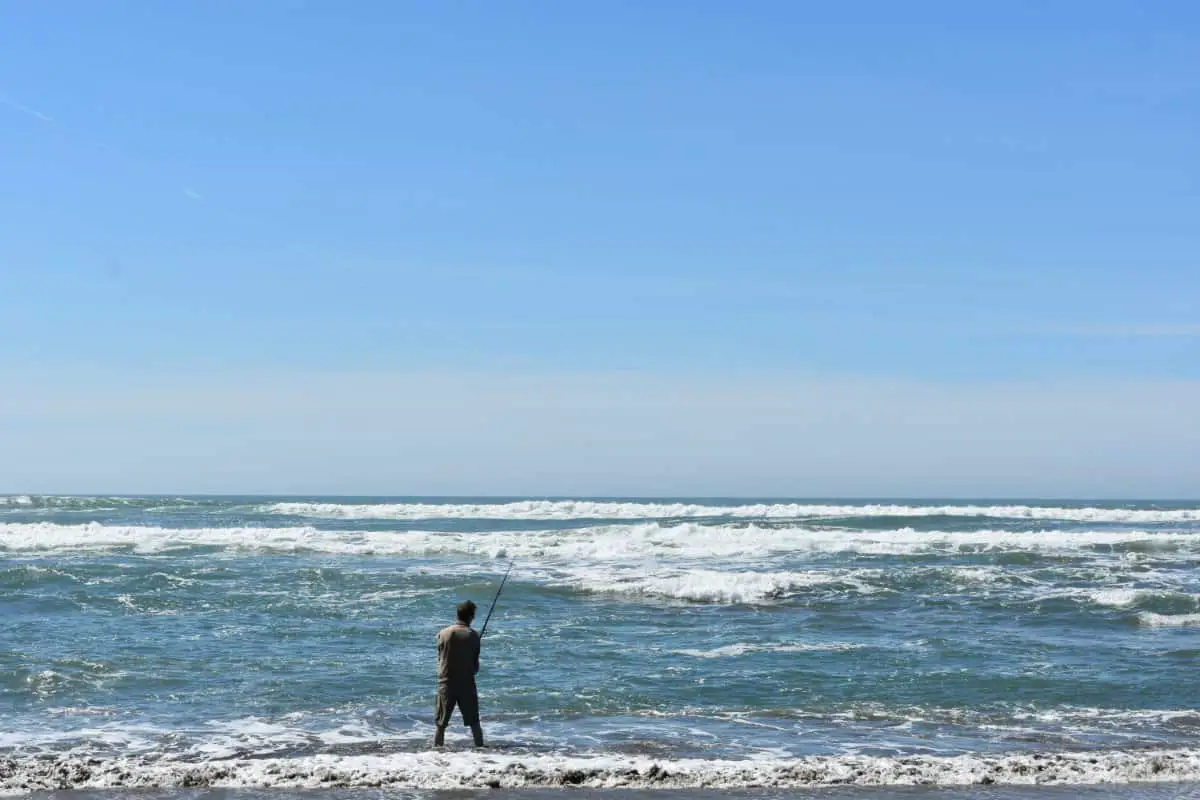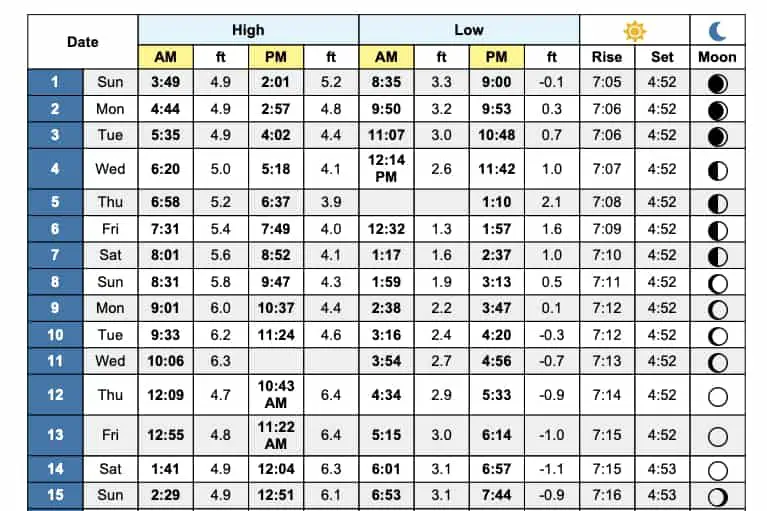If you are not an ocean-savvy person, you may be wondering what the matter is will all these tidal waves talk.
Many of the more experienced anglers often talk about the importance of the tide and how that relates to the best time to do surf fishing. Is surf fishing better at high or low tide?
Fishing 2 hours before high tide usually provides the best results for surf fishing. Surf fishing 2 to 3 hours before and after low tide can also work in certain areas and with certain fish. Slack tide, or when the tide changes, generally provides for the least amount of bites.
This is why I did a lot of research on the topic when I started surf fishing. Because although I love the ocean, I wasn’t really aware of some of the finer details surrounding the tidal waves.
What I found was a lot of interesting information that will hopefully help you too on your next surf fishing journey. So, without further ado here we go.
What Are High and Low Tides?
If you start surf fishing, you will inadvertently notice that the ocean level changes depending on the time of day you go to the beach.
Sometimes the ocean level will be high (high tide), and sometimes the ocean level will be low (low tide). But why exactly does that happen, and is there a pattern to it? Let’s find out.
What Causes High and Low Tide?
The gravitational pull of the moon causes the tides. Although the moon is much smaller than the Earth, it has enough gravity to affect many different things here on Earth – one of which, incidentally, is the ocean tides.
All bodies of water on the Earth (oceans, seas, lakes, etc.) that are closest to the moon are affected by it and bulge out.
Interestingly enough, the bodies of water that are farthest from the moon bulge out as well, creating another high tide on the opposite side of the Earth.
If an area is not in high tide, then it is in the low tide.
This means that there are always two high tides and two low tides on the Earth at any given time. And, typically, every area of the Earth will pass through both high and low tides each day.
Other Things That Can Cause High or Low Tide
Besides the two high and two low tides each day, every two weeks or so, there are recurring extreme tides and small tides (called spring and neap tides, respectively).
The reason for this is the sun.
They happen during the new moon and full moon phases![]() as a result of the Earth, moon, and sun aligning together.
as a result of the Earth, moon, and sun aligning together.
To a much lesser extent, strong winds, storms, hurricanes, and the different atmospheric pressure levels can also affect the level of the tide.
What Is the Best Tide for Surf Fishing?

Fish come during certain tide levels. Sometimes depending on the tide, you may not be able to catch even a single one.
Many professional anglers do plan their whole surf fishing trips around the conditions of the tide.
However, let me stop you right there. Before you continue, I need to tell you something important.
There is no best tide for surf fishing, per se. Depending on the individual situations, locations, weather conditions, and seasons it all can vary. The activity of fish is not the same across the board, and tides do not affect them the same way.
Both low and high tides can work for you sometimes.
And other times both of them may not work.
Depending on the season, the fish’s feeding behavior can change. For example, what has worked for you during the spring or winter may not work during the summer.
You can catch fish at pretty much any tide and time. Although the tide may provide certain advantages or disadvantages, the most important thing here is to go where the fish is. Make sure to understand and read the beach![]() , where the sandbars, cuts, and troughs are.
, where the sandbars, cuts, and troughs are.
And think of the tide as a part of the whole equation.
Surf Fishing in Low Tide and High Tide
One of the cool things about fishing in low tide![]() is that you can inspect and see the areas where you can potentially fish when the tide goes up.
is that you can inspect and see the areas where you can potentially fish when the tide goes up.
A good rule of thumb is to fish one to two hours before or two hours after low tide.
Low tide can be good for areas where you know predatory fish can catch their baitfish like pockets and channels.
Much like fishing in low tide, it is best to surf fish one to two hours before or after high tide.
However, there can be many exceptions to the rule. Frequently fish like to feed during high tide hence why it can potentially be a peak fishing time sometimes.
High tide, on the other hand, can spread fish out, so this may make high tide surf fishing actually very unproductive.
There will be a lot of water movement during the spring tides. And if you are fishing in areas with lots of structure, weeds and more this can make things quite difficult for you.
More on: How to Surf With Low Tide: Step By Step Guide![]()
Incoming vs. Outgoing Tides
The general consensus is that the upcoming high tide is the best time to go surf fishing.
Moving water, in general, provides for more bites. In other words, incoming or outgoing tides are best for surf fishing, and slack tides are usually the worst.
This is why, as I have mentioned above. Many anglers avoid fishing during the highest or the lowest point of the tide.
At this point, there is a water movement.
Depending on the area where you will be surf fishing, the tidal ranges can vary quite significantly. If the water current is too high, this can make it very difficult to surf fish in these conditions.
How Tides Affect Fish
Fishing with the tides, although not 100% necessary, is an important factor, especially for surf fishing.
Three main things determine the majority of fish’s behavior.
- Feeding;
- Comfort; and
- Spawning.
And the tide impacts one of the most important aspects of fish behavior, that is, its feeding patterns.
If you are after predatory fish, what you will find is that they may be caught during high tide as they try to feed on baitfish. Especially in areas with pockets.
Many of the predatory fish are constantly on the move. And as the tide changes, the fish will change their location as well.
On low tide, they will concentrate on areas where again baitfish will be focused the most. These are areas where the baitfish will pass through as they are going back with the low tide.
Is the Tide Important for Surf Fishing?

One of the frequent mistakes is to focus too much on the tide alone. Unfortunately, things are a little more complicated than just keeping an eye out for the rising tide.
The condition of the tide is just one of the variables you need to consider. Again these will vary greatly. To give the best possible prediction of how well your next surf fishing experience can go, you need to consider also some of the following factors as well:
- The time of the year (season);
- Type of fish species;
- Air pressure;
- Wind speed and direction;

- Moon phases (although somewhat controversial);
- The water temperature and visibility; and
- The weather.
With that being said, the tides do have a big impact on how fish will behave. Some areas can produce more bites on specific tides.
However, one crucial factor for surf fishing is the direction and strength of the current. Depending on the current, you may have an easier or harder time keeping the bait where the fish are.
How Do the Tides Ranges Vary?
One of the reasons why tides, although super important. Are also a tough subject to put your finger on is the fact that what is considered high and low tide can vary a lot.
What may work for high tide in the Gulf Coast may be inefficient on the East or the West Coast.
And here’s why.
Tides are not the same in different areas.
The difference between low tide and high tide is also known as the tidal range.
And the tidal ranges can vary a lot. Here are some very rough averages of the mean tidal ranges in the different areas:
- East Coast: from 18.20 feet in northern states like Maine to 0.68 feet in the southern states like Florida;
- Gulf Coast: typically, from 2.65 to 0.26 feet. Since most areas lie in relatively the same latitude there is not a significant difference here;
- West Coast: from 7.64 feet in northern states like Washington down to 3.57 feet in the southern areas like California;
There is also a fascinating data about Alaska.
- Alaska: from 25.95 feet in areas around Anchorage down to 2.32 feet in some of the outer islands of Alaska. As a matter of fact, the highest tidal ranges, of about 40 feet, recorded in the United States have happened near Anchorage.
Check out what 36 feet of tidal rise looks like:
How to Check the Level of the Tide and Other Variables
With all the technology we have today, we can really get the majority of the guessing out of the way.
There is an excellent online platform that you can use to check out what are the predictions for almost every single factor that can affect your fishing productivity.
I recommend using Tides4fishing.com, where you can check every little detail that you may need to know.
In fact, I am sure that you will get more than you asked for.
You will get information about:
- The overall weather conditions like wind, atmospheric pressure, visibility, and humidity;
- UV index
- Water and air temperature;
- The Swell condition;
- When the high and the low tides are expected;
- Tidal coefficient;
- Solunar and lunar activity, and so much more.
Of course, these are averages and predictions. These numbers can vary significantly as a result of the weather changes.
And all of these, as you already know, can be very important in catching fish.
However, if you just can’t help but feel overwhelmed by all this information. And need a reliable source of only when to expect the high or low tides, there is another solution you can use.
There is an excellent free app that you can use on your smartphone called Tides Near Me, which you can use to monitor the tides.
And last but not least, you can get a tidal chart from your local tackle shop.
Having excellent means of predicting the tides can be the difference between catching a lot of fish versus going home empty-handed.
Can Surf Fishing Be Done at High or Low Tide at Night?
Yes, surf fishing at night can be done during both high and low tide. Some anglers prefer high tide because it brings the fish closer to shore, while others have success during low tide when fish are concentrated in deeper channels. The key is to understand the fish behavior and adjust your strategy accordingly.
How to Read a Tide Chart


At first, reading the tide chart can be a bit intimidating, but bear with me on this one. You will see that it is not difficult at all.
The Tidal Current
The first thing you want to look at is the current.
These numbers on the chart will represent how much will the water level change. The steeper the angle or, the bigger the number, the faster the movement is. And as a direct result, the higher the current.
Many anglers may want to avoid fishing in fast waters and fast currents, especially if they are deep fishing.
A neat way to judge and predict how strong the current will be is by checking out the difference between low tide and high tide.
Usually, there are about six or so hours between high and low tide. This can vary a lot, so keep this in mind.
If there is a low tide of 1 foot and a high tide of 5 feet. This means that the water has six hours to raise from one to five feet, and there will be a powerful current and a lot of water movement.
On the other hand, if the low tide is 2.5 feet and the high tide is going to be 3.2 feet, this means that in the span of the next six or so hours, the water will rise by just 0.7 feet. The water will be much calmer, and there won’t be much of a current.
The Tidal Coefficient
The other thing that can help you is the tidal coefficient. The tidal factor is used to predict how strong the current will be, and it indicates how high or low the tides are expected to get.
The tidal coefficient can be from 20 to 120. The higher the number, the – higher the difference between the low and high tide is going to be, and the more water movement there will be.
The Moon Phases
Last but not least, it is crucial to consider the moon phases as they do affect how fish acts. The moon and the tides are interconnected and always go hand in hand.
Generally speaking, the days leading to a full moon or new moon can be very productive. And many people avoid fishing the first few days after a full moon.
On the other hand, this is considered a somewhat controversial topic and just a superstition by many.
Although the data is not concrete, I would suggest to make a mental note of the moon phases just in case and see how the work for you.
Final Words
I would concur with other fishermen, saying that the best time to surf fish is whenever you have the time for it. If we keep on waiting for the perfect conditions, let me tell you, we may never even catch a single fish.
All of these tips and tricks are great to give you a little edge when it comes to surf fishing. However, don’t take them as set in stone rules that you must always obey.
Having more in-depth knowledge and understanding is excellent, but don’t let that stop you from fishing.
Many anglers, including myself, have had some of their best days in conditions that seemed unfavorable.

